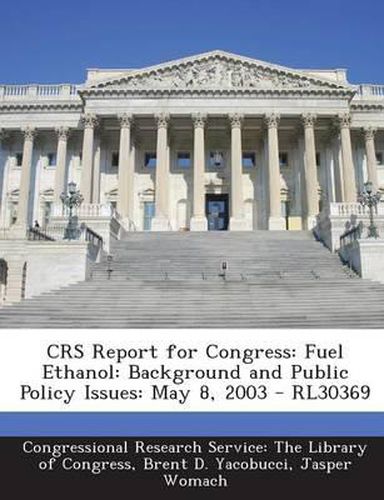Readings Newsletter
Become a Readings Member to make your shopping experience even easier.
Sign in or sign up for free!
You’re not far away from qualifying for FREE standard shipping within Australia
You’ve qualified for FREE standard shipping within Australia
The cart is loading…






In light of a changing regulatory and legislative environment, concern has arisen regarding the future prospects for ethanol as a motor fuel. Ethanol is produced from biomass (mainly corn) and is mixed with gasoline to produce cleaner-burning fuel called “gasohol” or “E10.” The market for fuel ethanol, which consumes 10 % of the nation’s corn crop, is heavily dependent on federal subsidies and regulations. A major impetus to the use of fuel ethanol has been the exemption that it receives from the motor fuels excise tax. Ethanol is expensive relative to gasoline, but it is subject to a federal tax exemption of 5.2 cents per gallon of gasohol (or 52 cents per gallon of pure ethanol). This exemption brings the cost of pure ethanol, which is higher than that of conventional gasoline and other oxygenates, within reach of the cost of competitive substances. In addition, there are other incentives such as a small ethanol producers tax credit. It has been argued that the fuel ethanol industry could scarcely survive without these incentives. The Clean Air Act requires that ethanol or another oxygenate be mixed with gasoline in areas with excessive carbon monoxide or ozone pollution. The resulting fuels are called …
$9.00 standard shipping within Australia
FREE standard shipping within Australia for orders over $100.00
Express & International shipping calculated at checkout
In light of a changing regulatory and legislative environment, concern has arisen regarding the future prospects for ethanol as a motor fuel. Ethanol is produced from biomass (mainly corn) and is mixed with gasoline to produce cleaner-burning fuel called “gasohol” or “E10.” The market for fuel ethanol, which consumes 10 % of the nation’s corn crop, is heavily dependent on federal subsidies and regulations. A major impetus to the use of fuel ethanol has been the exemption that it receives from the motor fuels excise tax. Ethanol is expensive relative to gasoline, but it is subject to a federal tax exemption of 5.2 cents per gallon of gasohol (or 52 cents per gallon of pure ethanol). This exemption brings the cost of pure ethanol, which is higher than that of conventional gasoline and other oxygenates, within reach of the cost of competitive substances. In addition, there are other incentives such as a small ethanol producers tax credit. It has been argued that the fuel ethanol industry could scarcely survive without these incentives. The Clean Air Act requires that ethanol or another oxygenate be mixed with gasoline in areas with excessive carbon monoxide or ozone pollution. The resulting fuels are called …